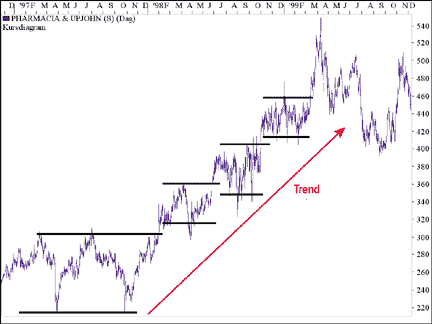TRADING TECHNIQUES
Determining Balance Points In Crowd Psychology
by Carl Gyllenram
Balance points, the pivotal points between the swings of the bulls and the bears, turn out to be excellent ways to determine market moods and to spot breakouts from a trading range.
People have banded together in groups since prehistoric times. Originally, it was necessary for the survival of the individual to belong to a group, tribe, or herd. If you as a solitary hunter had tried to bring down a mammoth with a wooden spear, your chances of success or even survival would have been very slim. But if you had joined with others and cooperated toward that common goal, your chances of bringing down large animals and thus securing the survival of the tribe would have been greatly enhanced.

FIGURE 1: TREND. Even though Pharmacia & Upjohn was in an uptrend between November 1997 and April 1999, it spent most of that time ranging/congesting.
The desire among humans to belong to a group of likeminded individuals is as old as our existence. To feel accepted in some sort of community contributes to a sense of security and well-being.
To foresee the behavior of an individual in a specific situation, however, can be problematic. On the other hand, the behavior of a larger group is quite possible to foresee with quite a high degree of certainty. If a fire broke out in a packed movie theater or on a dance floor, for example, it would require no insight to conclude that the majority of those people would try to get out as soon as possible.
People in such situations are individuals who happen to be in the same place at the same time. When the environment is friendly and pleasant, there are no signs of crowd behavior. But if these people were exposed to an apparent external threat and impending pressure, a sense of anxiety and insecurity would arise, which would in turn influence most of those people to act more emotionally and make them behave as a crowd instead of independent-minded individuals.
The same, of course, could be said for those in the financial markets.
CROWD PSYCHOLOGY IN THE MARKETS
As Tony Plummer points out in Forecasting Financial Markets, two important conclusions can be drawn from the study of crowd psychology: first, a crowd is something other than the mathematical sum of its parts, and second, the behavior of the individual changes when he or she is in a crowd. Three conditions must be fulfilled in order for an individual to belong to a group, and these same conditions must be established in the financial markets for crowd behavior to rule. The person in question must:
1 Identify himself with the group. Every trader or investor has a plain and common purpose -- to make money -- and feels kinship with other stock market investors.
2 Accept the rules and standards of the group. In these situations, the trader or investor has a tendency to accept the prevailing opinion about the direction of the price.
3 Accept the leader of the group. In the market, the price that moves in an obvious direction fulfills the leadership function for the crowd.
Carl Gyllenram is the founder of the Swedish Technical Analyst Federation and a board member of The International Federation of Technical Analysts. He is a senior asset manager at SEBEnskilda Banken, the largest asset manager in Scandinavia.
Excerpted from an article originally published in the June 2000 issue of Technical Analysis of STOCKS & COMMODITIES magazine. All rights reserved. © Copyright 2000, Technical Analysis, Inc.
Return to June 2000 Contents